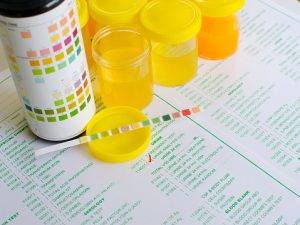
Causes of ketonuria
Ketonuria is simply a diagnostic finding that helps medical professionals identify a cause in order to correct it. Our bodies use a combination of carbohydrates, proteins, and fats to fuel cellular tissue. Glucose is the most important energy source as it can be easily utilized by your cells. However, this is only if the hormone insulin is on board to help facilitate the deliverance of glucose into the cell. Metabolic conditions, such as diabetes mellitus, are able to efficiently use glucose and force the body to use other means for producing energy.
The following are ketonuria associated conditions:
Starvation
When you don’t consume food for a long period of time, your insulin decreases. Once our body has depleted reserve glucose stores in the body, it will begin to cannibalize your fat and muscles, creating ketone bodies as an alternative fuel source known as ketosis.
Digestive disturbances
If the intake or absorption of carbohydrates become compromised, your body will lean on converting fat and muscle into the energy it needs. This will lead to the development of ketone in the blood and in the urine.
Related: Hematuria (blood in urine): Signs, symptoms, causes, prevention, and natural remedies
Dietary imbalance
Eating a diet that is primarily high in fat or low in carbohydrates can effectively shift the majority of your energy source stemming from fat, creating ketones in the process.
Strenuous exercise
When you exercise too hard, it creates more demand from your muscles to give them energy. If the body has an absence of glucose stores, your body will use an alternative source of energy: fat. While it is most desirable to lose weight, it will cause ketone production, which is eventually excreted through the urine.
Excessive vomiting and diarrhea
Essentially causes the body to go into starvation mode as it tries to break down fat as its fuel source. This will lead to the production of ketones, which gets excreted into the urine.
Symptoms of ketonuria
Symptoms that are present in a patient with ketonuria will depend on the underlying cause. For the most part, patients will often come in with a previous diagnosis of type 1 diabetes that is poorly managed. The following may be seen upon presentation:
- Fruity smelling breath: A common sign looked for by medical professionals, especially when diabetes has been rushed to the emergency room. This is from a ketone called acetone, which has a fruity odor that is excreted through the lungs.
- Frequent urination: A common sign of diabetes as the body tries to get rid of ketones in the blood, increasing the urge to urinate.
- Dehydration and excessive thirst: Due in part to the frequent urination but also from nausea and vomiting as well.
- Nausea and vomiting: Ketone accumulation within the blood can cause an imbalance of other various electrolytes such as sodium and potassium. Having low levels of these electrolytes can lead to nausea and vomiting if not corrected.
- Heavy breathing: Increased ketone concentration in the blood can lead to deep, heavy, and labored breathing.
- Confusion and disorientation: Excess ketones can have a harmful effect on the brain over time.
Diagnosis and treatment for ketonuria
Detecting ketones in the urine is often a simple process that can be done quickly by a urine dipstick. However, ketones can also be identified using blood tests, but this would require more time and a blood sample.
The normal range for finding ketones is less than 0.6mmol/L and they’re often presented as having a negative result. A positive result may be triggered if your ketone levels fall in the range of 0.6-1.5 mmol/L, which will prompt your doctor to perform further testing looking for diabetes.
Treatment for ketonuria will also depend on the underlying cause. In the case of diabetic patients, properly managing glucose levels and adhering to appropriate lifestyle modifications will ensure that ketonuria is not obtained.
Poorly controlled diabetes may result in a condition called ketoacidosis, a life-threatening condition that results from dangerously high ketone levels and blood sugar, causing the blood to become excessively acidic. Having an acidic environment can affect the function of internal organs, such as your kidneys or liver, leading to dangerous situations. When a person with diabetic ketoacidosis (DKA) arrives at the emergency room, the following are some of the most commonly done practices to help reduce mortality:
- IV fluid replacement: Due to excessive fluid loss.
- Electrolytes: Potassium, sodium, chloride, and other important electrolytes need to be rebalanced to ensure vital structures such as the muscle and the heart can function normally.
- Insulin: The most important treatment for patients suffering from DKA as it will improve their ability to use excess glucose in the blood for energy.
Prevention of ketonuria
Prevention of ketonuria will require the proper management of your diabetes, which is the most common cause of their appearance in the urine. This means you will have to keep blood sugar levels healthy by regularly checking them and adhering to the doctor’s instructions.
It is important to keep in mind the food you consume when suffering from diabetes as some foods will boost blood sugar levels. Following a proper diet that consists of a balance of fats, proteins, and carbs and making sure you take insulin injections at properly designated times will ensure ketonuria does not manifest.
Related:
Proteinuria (protein in urine) causes, complications, and symptoms
What is sediment in urine? Causes, symptoms, and treatment